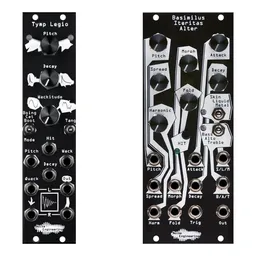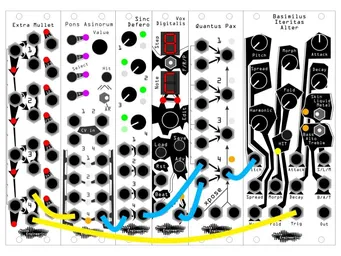The Basimilus Iteritas Alter is a great voice for drum sounds. However, there are some sounds that are a bit more difficult to create with it - at least without some creative patching. Today, we’re going to look at some ways to make classic 808-style kicks with the BIA.
Before we talk, let’s talk about what we’re talking about
The TR-808 is a drum machine. Maybe you’ve heard of it. It has a long history, and has been used on countless classic records. The thing is, people often use the phrase “808” to refer to any long synthetic kick drum. This makes things confusing, as you’ll often hear things referred to as “808’s” that sound nothing like the TR-808 kick. The 808-style of percussion is widely used because it sounds great, so we’ll take inspiration from it, even if we don’t end up with an exact copy.
Learn more:
BIA kicks
On its own, the BIA makes some truly awesome kicks. However, they can be pretty aggressive and beefy with a LOT of transient material (the big impactful part of the kick) and not a lot of tail. 808-style kicks, however, have a less present transient and a long, subby decay. If we put the BIA in Liquid mode and turn the Decay all the way up, it sounds more like a laser than an 808 kick. So how do we make it more 808-esque?
Pitch bend (insert laser noises here)
The easiest way to make a kick is with a fast pitch envelope. Liquid mode has a built-in pitch envelope, but it doesn’t quite work for what we want it to do. If we put the BIA in Skin mode we can get a long subby decay, but there won’t be as much impact. OG Basimilus Iteritas users know that you can get a pretty awesome kick with Skin mode, but we want to add a bit more character here. All we need is a fast decay envelope and an attenuator. The Pitch input, while calibrated for 1v/8va CV signals, is basically just an exponential FM input, perfect for our needs.
The patch

This one’s pretty straight forward. Since the BIA obviously doesn’t have any kind of attenuator on its pitch input, we need an external one so we don’t go full psytrance. (Unless you want to. I won’t judge.) I like Sinc Defero for attenuation, but it can really be anything (this doesn’t have to be precise). We also need a decay envelope. I like Stages, or you could use Pons Asinorum, or Maths, or whatever you have in your system. You can also use an AD envelope if you want a little bit more control over tone; a really short attack stage on a pitch envelope can make some interesting tonal changes in a kick. Trigger both the envelope and the BIA at the same time, and you’re off! You can see that patch above. Note that turning the Attack knob just a little past 12 o’clock can give you some different character at the beginning of your kick, so it’s worth experimenting. Here’s what it sounds like:
But that’s boring af
Remember when I talked about how things people call “808s” really aren’t 808 kicks? One thing you couldn’t do on an actual 808 but is common in modern production with 808-style kicks is pitch sequencing. We can do that, but we need to patch a bit of a workaround, since the BIA only has one pitch input. Use a precision adder like Quantus Pax to mix your pitch sequence with the pitch envelope we were using to make the kick, too. That would look like this:

And it sounds like this:
Grab yourself a blender cuz it’s time for some MIXING (Note: Noise Engineering does not recommend putting your modules in a blender)
As I said earlier, the processing on the 808 is part of what the sound is known for, weirdly. One of my favorite techniques is one we mentioned last week: parallel processing! We’ll definitely want some compression. I like the Autodyne, since it basically has parallel stuff built in, and it sounds great, too. I use the Erica Synths Drum Mixer for all my percussion which has a built-in compressor and also tends to clip a bit when you really drive it. The important thing is to keep a balance between clean and distorted. It’s easy to over compress and over distort stuff so go easy on your percussion.
In conclusion
Sometimes some creative patching can get you whole new sounds out of modules you already have. You may be surprised by what possibilities are already in your system! The next time you want a new module, take a moment and think, “is there a way I could do this with modules I already have?” And then go buy a new Noise Engineering module anyway. You know you want to.





